
|
In El Salvador
the boat was anchored in an estuary (Estero Jaltepeque). In order
to enter the estuary a river
bar with breaking waves had to be crossed. Here is a photo of
boats milling
about waiting their turn to cross the bar (Tricia Jean is the boat on
the far
left).
|
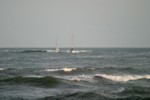
|
Here we are actually crossing
the bar. Tricia Jean is the boat with the breaking wave
right behind it. We were lucky and had a very easy
crossing. The boat right behind us got sideways at one point and
took a breaking wave on her side, resulting in some sea water in the
cabin of the boat.
|

|
A shot of us avoiding yet
another breaking wave.
|

|
From our anchored boat in the
estero we had a view of a distant volcano.
|
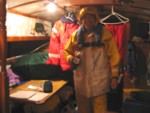
|
Shortly after we arrived at
Bahia del Sol (aka Estero Jaltepeque), hurricane Adrian came by for a
visit. It missed us by about 35 miles, so while we had some wind
and torrential
rain, no boats in the area sustained any damage. Here is
Dan about to go topside during the height of the storm and check the
anchor lines to make sure they are not chafing.
|

|
Notice the line in the
sky. Bright sunshine to the left and shadow to the right.
We saw this happen a couple of times at Bahia del Sol, but never
figured
out what caused it.
|
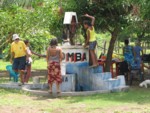
|
The water supply at village
school on one of the nearby islands was this hand cranked pump that
produced brackish water. The wells and pumps were built many
years ago by a French government aid mission.
|
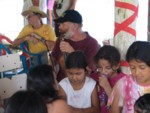
|
A friend, Joe from
Panacea, sits with his ever present
fiddle surrounded by local children at a mother's day celebration.
|

|
These dugout canoes, cayugas
(pronounced ki-u-gas, long i and u, short a), were everywhere.
Most of them were unpainted and unadorned in any way. This one had
recently been painted.
|

|
Near our anchored boat,
there was a small mangrove covered island (called by the cruisers, Bird
Island) that
housed an enormous number of nesting birds. Mostly cattle egrets
and some herons.
|
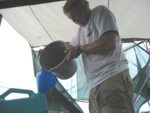
|
Dan collecting rain for the
water tanks.
|
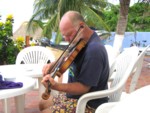
|
Here's Joe in
the pose in which I (Dan) will probably always remember him:
Violin tucked under his chin, eyes closed and his large fingers somehow
drawing forth sweet music from the instrument.
|
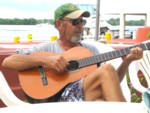
|
Bill from Mita Kulu. Bill
could be described as a proselytizing
musician. He was forever encouraging others to let him teach them
to play an instrument or to join him in practice sessions.
|

|
We accept a number of
compromises to enjoy the cruising lifestyle. One of them is the
lack of living space. Here is the entire
kitchen area of Tricia Jean. On the plus side, you
don't do a whole lot of walking around, but there is a
distinct lack of counter space and a teeny, tiny sink.
|
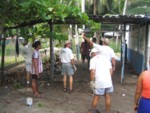
|
One of the three school rooms on
a
nearby island was little more than a mud floored lean-to
structure. The cruisers took on as a project replacing it with a
far better structure. Here we are tearing down the old room.
|
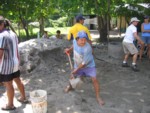
|
The locals enthusiastically join
us in the work. Here, we are moving a big pile of sand to fill
in the foundation to raise the floor up above the flood level.
|
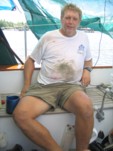
|
A very exhausted Dan after a day
of hard work tearing down the old school room and preparing the
foundation for the new one.
|
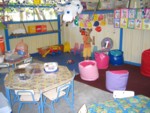
|
Four year old Andrew from Soy
Libre is checking out the new school room the cruisers built. He
likes what he sees.
|
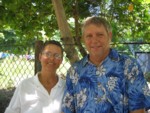
|
Dan and Kathryn all dressed up
for
the inauguration ceremony for the new school room.
|
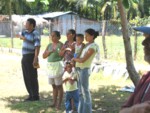
|
Most of the Salvadorans were
very patriotic. Here is a family rendering the civilian salute as
their national anthem is played at the start of the inauguration
ceremony.
|
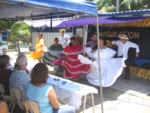
|
The day included local dancers
who entertained us with folkloric dances. The new
school room is the one on the left with the sheet metal walls and
blue trim around the windows. Philip from Carina is the light
haired
man is seated with his back to us. He was the primary organizer
of the project.
|
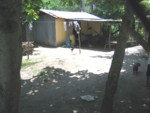
|
Another "be grateful for what
you've got" photo. This one of a typical Salvadoran home.
In fact, it was right next door to the school.
|